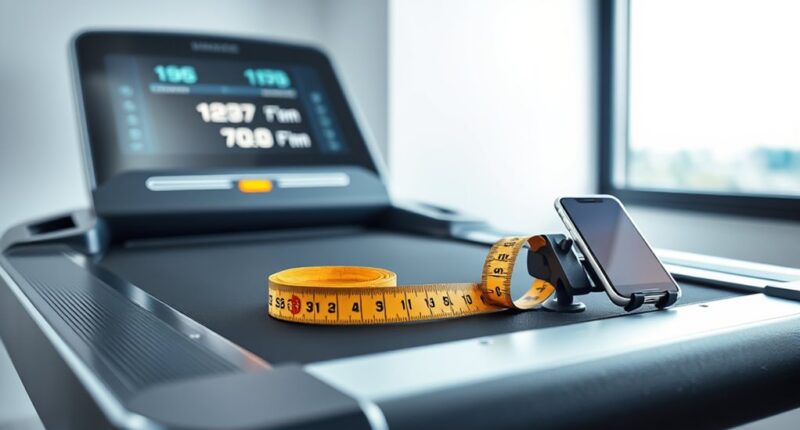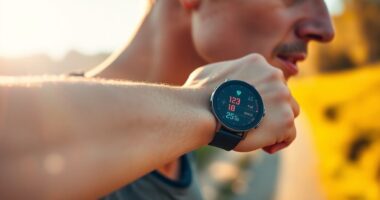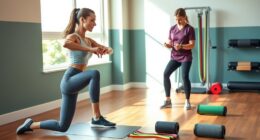If your treadmill’s “5K” display seems off, it may be due to calibration issues or sensor problems. Over time, sensors can drift, get dirty, or misalign, causing inaccurate distance measurements. Software errors or moving the treadmill can also throw off calibration. Regularly checking and recalibrating guarantees your data stays reliable, helping you track progress more accurately. Keep exploring to learn simple steps to fix these common issues and improve your workout results.
Key Takeaways
- Sensor drift or misalignment can cause inaccurate distance readings, making your indoor 5K appear longer or shorter.
- Calibration errors from outdated firmware or improper setup may lead to incorrect distance calculations.
- Environmental factors like temperature or humidity can affect sensor performance and measurement accuracy.
- Moving or not recalibrating the treadmill after long periods can cause drift, impacting accurate 5K timing.
- Using unreliable measurement tools or skipping calibration checks can result in inaccurate distance tracking during workouts.
How Treadmill Distance Measurements Work
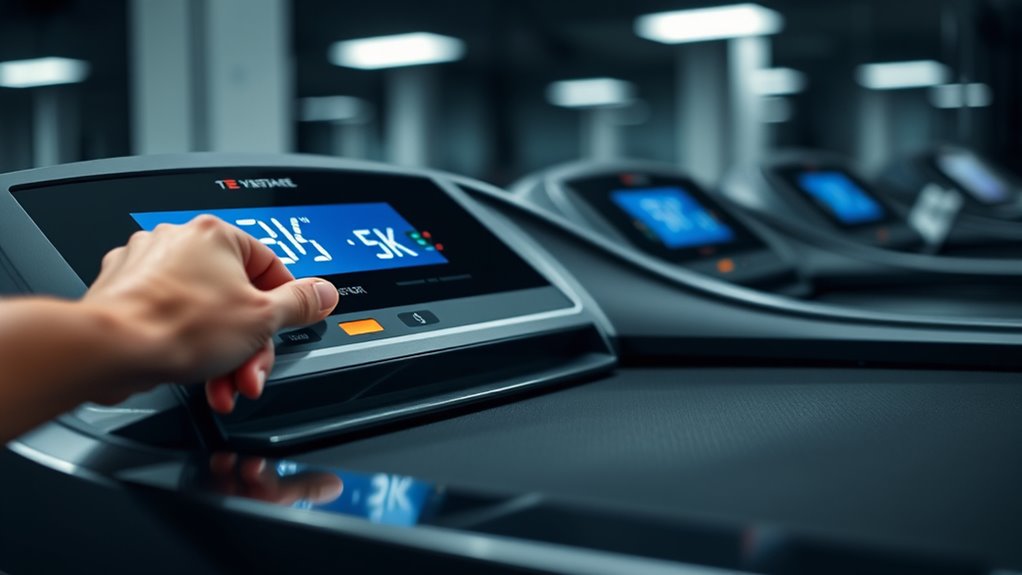
Understanding how treadmill distance measurements work is essential for ensuring your workouts are accurate. Treadmills rely on sensors to track your movement, but their accuracy depends heavily on sensor quality and placement. These sensors detect belt speed and rotation, which are then processed through measurement algorithms to calculate distance. These algorithms interpret data from the sensors, converting belt rotations into miles or kilometers based on preset calibration. If sensors lack precision or the algorithms are flawed, your distance readings may be off. High-quality sensors with better sensitivity improve measurement accuracy, while sophisticated algorithms can compensate for minor inconsistencies. Proper calibration and high-quality components are crucial to maintaining measurement accuracy, especially in advanced models that incorporate features like Volkswagen Tuning concepts such as engine calibration to optimize performance. Additionally, sensor placement plays a critical role in ensuring the accuracy of distance measurements, as improper positioning can lead to inconsistent readings. Knowing this helps you understand why some treadmills might underestimate or overestimate your distance, emphasizing the importance of proper calibration and quality components.
Common Causes of Calibration Errors
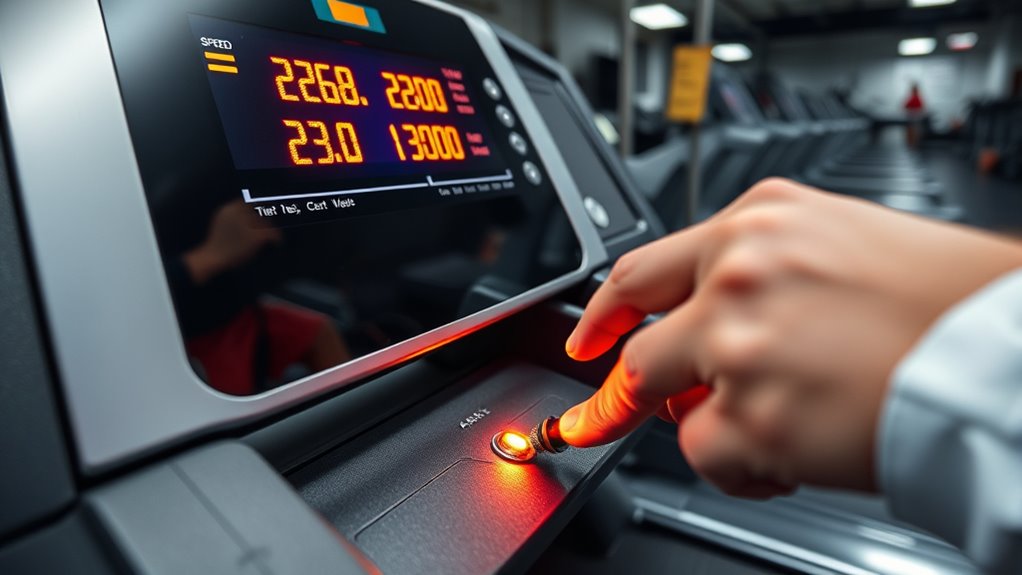
Calibration errors often happen because of drift over time or faulty speed sensors. If you don’t regularly check your treadmill, small inaccuracies can add up. Identifying these issues early helps keep your calibration precise. Incorporating regular maintenance routines can further prevent calibration drift and ensure accurate performance. Additionally, understanding the engine tuning options can help tailor your maintenance routine to suit specific needs. Regular inspection and adjustment of the sensor alignment can also significantly improve calibration accuracy.
Calibration Drift Over Time
Over time, even well-maintained treadmills can experience calibration drift, which can lead to inaccurate speed and distance readings. Sensor drift occurs as components age or become less precise, causing the sensors to send incorrect signals. Software errors can also play a role, especially if firmware updates introduce bugs or if internal algorithms malfunction. These issues gradually accumulate, making your treadmill’s readings less reliable without any obvious signs. Regular use, environmental factors like temperature and humidity, and internal wear all contribute to calibration drift. To maintain accuracy, it’s important to periodically recalibrate your treadmill and stay aware of potential sensor or software issues that can affect performance over time.
Inaccurate Speed Sensors
Have you ever noticed your treadmill’s speed readings seem off even after calibration? Inaccurate speed sensors are a common culprit. Sensor malfunctions, such as dirt buildup or wear, can cause faulty readings. Sometimes, the sensor’s hardware may be damaged, leading to inconsistent signals. Firmware updates can also impact sensor performance, especially if they introduce bugs or compatibility issues. If your treadmill’s software isn’t up to date or has recent updates gone wrong, it might misinterpret sensor data, resulting in incorrect speed measurements. To fix this, clean or replace the sensor if needed, and ensure your treadmill’s firmware is current and properly installed. Addressing sensor malfunctions and updating firmware can considerably improve calibration accuracy. Being aware of narcissistic behaviors can also help in recognizing and troubleshooting underlying issues affecting equipment or interactions. Additionally, understanding how crypto regulation frameworks evolve can influence your strategies for investing in digital assets. Regular maintenance and understanding common sensor issues can help prevent recurring calibration problems and ensure your treadmill performs accurately.
The Impact of Calibration Issues on Your Workout

When your treadmill isn’t properly calibrated, your workout can become less effective and even misleading. You might think you’re hitting your target pace, but the actual distance or effort could be off. This affects your heart rate monitoring accuracy, making it hard to gauge intensity correctly. Additionally, incorrect incline settings can skew calorie estimates and perceived exertion. Here’s how calibration issues impact you:
- Misleading Distance and Pace: You may run less or more than intended, affecting training progress.
- Inaccurate Heart Rate Data: Your heart rate monitor might not reflect your true effort, leading to over- or under-training.
- Erroneous Incline Feedback: Incline settings may not match real terrain, skewing workout difficulty.
- Reduced Motivation: Inconsistent data can make workouts feel ineffective, discouraging consistency.
- Calibration Accuracy is crucial for maintaining reliable workout data and achieving your fitness goals.
Signs That Your Treadmill Might Be Off

If your treadmill isn’t calibrated correctly, you’ll notice certain signs during your workouts that indicate something’s off. You might feel like your pace isn’t matching the speed displayed, or your distance seems inaccurate despite consistent effort. User feedback often highlights discrepancies between perceived exertion and actual results, raising red flags. Additionally, irregular treadmill behavior—such as sudden jolts or inconsistent belt movement—can signal calibration issues. Poor treadmill maintenance can exacerbate these problems, leading to unreliable readings. Keep an eye on these signs to avoid overtraining or underestimating your progress. Addressing calibration problems early ensures accurate performance tracking and keeps your workouts effective.
| Sign | Effect on Workout | Emotional Impact |
|---|---|---|
| Mismatch between speed and effort | Frustration, confusion | Feeling lost or unmotivated |
| Inconsistent distance readings | Loss of confidence in progress | Doubt about your fitness |
| Sudden belt jolts or stalls | Safety concern, interruption | Anxiety or concern |
| Discrepancies in user feedback | Distrust in treadmill accuracy | Frustration, disappointment |
Methods to Check and Confirm Your Treadmill’s Accuracy

To guarantee your treadmill provides accurate readings, you should regularly perform specific checks that verify its calibration. Proper treadmill maintenance enhances your user experience and ensures precise data.
- Use a known distance, like a measured track or outdoor route, and run on your treadmill to compare the displayed distance.
- Check the speed settings by timing yourself over a set distance, then compare your pace to the treadmill’s reading.
- Use a smartphone app or GPS device to track your outdoor run and compare it with your treadmill data.
- Inspect the treadmill’s belt alignment and surface for any irregularities that could affect accuracy.
These simple tests help confirm your treadmill’s calibration, keeping your workouts effective and reliable.
Tips for Properly Calibrating Your Treadmill at Home

To make certain your treadmill runs accurately, start by checking and adjusting the calibration settings. Use precise measurement tools, like a measuring tape or smartphone app, to verify your speed and distance. Properly calibrating your machine helps you get the most accurate workout data and prevents misleading results.
Check Calibration Settings
Before you begin calibrating your treadmill, confirming that the calibration settings are accurate is vital. First, check the manufacturer settings to ensure the treadmill defaults haven’t been altered. Second, verify if your model allows user adjustments and locate the calibration options in your user manual. Third, reset the treadmill to factory settings if needed, to eliminate any incorrect modifications. Fourth, double-check that the current calibration aligns with the treadmill’s display, making sure it’s not misreporting speed or distance. Making certain these settings are correct prevents errors during calibration. Properly confirming manufacturer defaults and user adjustments sets a solid foundation for accurate calibration, ensuring your treadmill provides reliable readings during your workouts.
Use Accurate Measurement Tools
Using accurate measurement tools is essential for calibrating your treadmill correctly. Reliable tools help you verify speed and distance, ensuring your pacing strategies are precise. Avoid guesswork by using a measuring tape for distance or a smartphone app with GPS to track your runs. Different treadmill brands may have slight variations, so consistent measurement methods are key. Use a stopwatch or timer to cross-check speed accuracy during calibration. Investing in a high-quality, calibrated external device can improve your calibration process. Accurate tools provide confidence that your treadmill matches real-world conditions, giving you better training results. Proper measurement ensures your “5K” time is realistic and consistent, regardless of treadmill brand. This precision helps prevent over- or underestimating your pace during indoor workouts.
When to Seek Professional Calibration Services

Knowing when to seek professional calibration services guarantees your treadmill stays accurate and safe to use. If you notice persistent discrepancies in your workout data or experience unusual noises during operation, it’s time to call in calibration experts. Here are four signs you should consider professional assistance:
- Your treadmill’s pace or distance readings are inconsistent despite recalibrating.
- You’ve moved the treadmill to a new location or it’s been unused for a long period.
- Regular calibration attempts haven’t corrected errors.
- You want to ensure maximum accuracy for training or health tracking.
How Accurate Data Can Improve Your Training Results
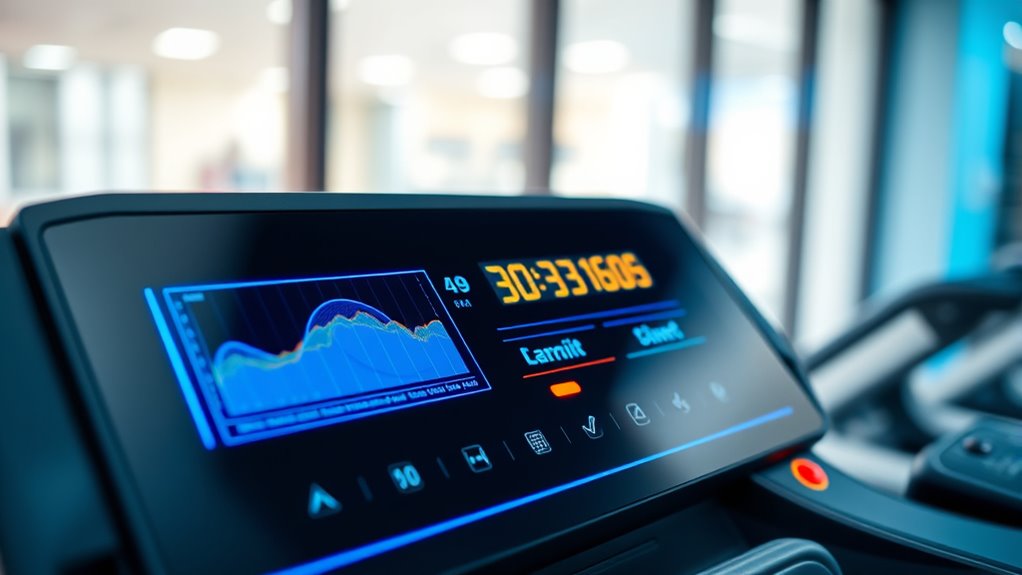
Accurate data from your treadmill can substantially boost your training effectiveness by providing reliable feedback on your performance. When your treadmill measurements are precise, you can better track your heart rate monitoring to stay within suitable zones, ensuring you’re training effectively without overexertion. Precise data also helps you adjust incline settings accurately, simulating outdoor terrain and increasing workout intensity safely. This allows you to tailor your workouts for better endurance, speed, and calorie burn. When your treadmill’s data aligns with actual performance, you gain confidence in your progress and can make informed decisions about pushing harder or scaling back. Ultimately, accurate data ensures your indoor runs are as effective as outdoor ones, helping you reach your fitness goals faster and more efficiently.
Frequently Asked Questions
How Often Should I Calibrate My Treadmill for Optimal Accuracy?
You should calibrate your treadmill at least once every three to six months to maintain accuracy. Follow a proper maintenance schedule and use accurate calibration techniques, especially if you notice inconsistencies in your pace or distance. Regular calibration guarantees your workouts are reliable and your data precise. Don’t wait until performance drops; proactive calibration keeps your treadmill running smoothly and your exercise results trustworthy.
Can External Factors Affect My Treadmill’s Calibration Over Time?
Think of your treadmill as a delicate dance partner, easily thrown off by environmental fluctuations and wear and tear. Over time, temperature changes, humidity, and dust can subtly shift calibration, making your runs less accurate. These external factors act like mischievous winds, nudging your equipment off course. Regular checks and maintenance help keep your treadmill in sync, ensuring your indoor 5K stays true to the distance you aim for.
Are There Specific Brands That Are More Prone to Calibration Errors?
Some brands are more prone to calibration errors due to inconsistent calibration processes. You’ll find that lesser-known or budget brands often have lower brand reliability and may lack rigorous calibration consistency. To guarantee accurate readings, opt for reputable brands known for quality and regular calibration checks. By choosing trusted brands, you reduce the risk of inaccurate distances and improve your indoor running experience.
What Tools or Equipment Are Needed for Professional Calibration?
To professionally calibrate your treadmill, you’ll need calibration equipment like a precision speed sensor, a stopwatch, and a measuring tape. These tools help make certain your treadmill meets measurement standards for accuracy. You also need a level to check the surface. Using calibration equipment correctly guarantees your treadmill’s speed and distance readings are reliable, giving you confidence in your workouts. Proper calibration keeps your fitness goals on track.
How Does Incorrect Calibration Impact My Long-Term Fitness Progress?
Imagine your fitness journey as a delicate dance; incorrect calibration can subtly throw off your rhythm. When your treadmill isn’t accurately calibrated, your fitness tracking might overestimate or underestimate your progress. This can lead to inconsistent workouts, making it harder to maintain workout consistency. Over time, these small discrepancies can slow your long-term fitness progress, leaving you uncertain if you’re truly advancing or just chasing an illusion.
Conclusion
By understanding how your treadmill measures distance, recognizing calibration issues, and regularly checking its accuracy, you can guarantee your workouts are true to your goals. Proper calibration helps you track progress, avoid overestimating or underestimating your efforts, and stay motivated. Keep your treadmill calibrated, your training honest, and your results real. When you do, you’ll run confidently, measure precisely, and reach your fitness milestones with clarity and consistency.
